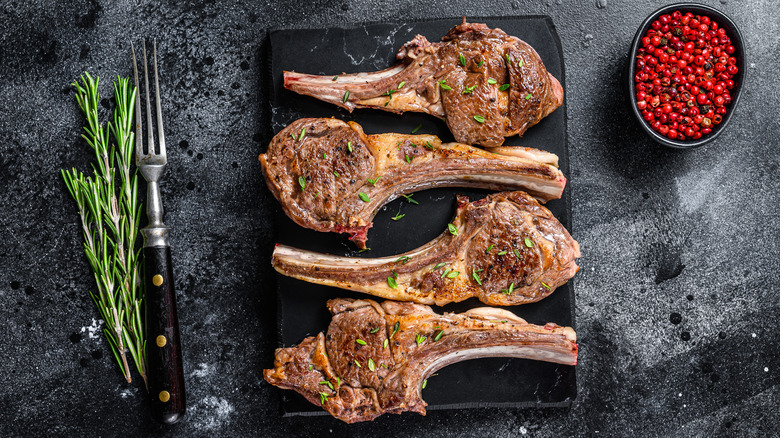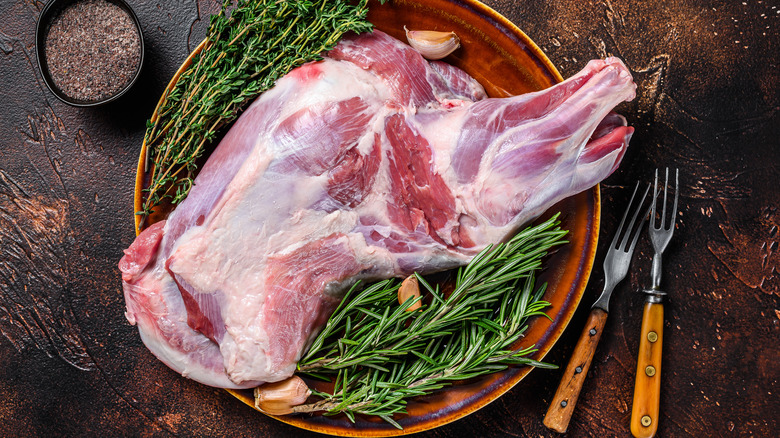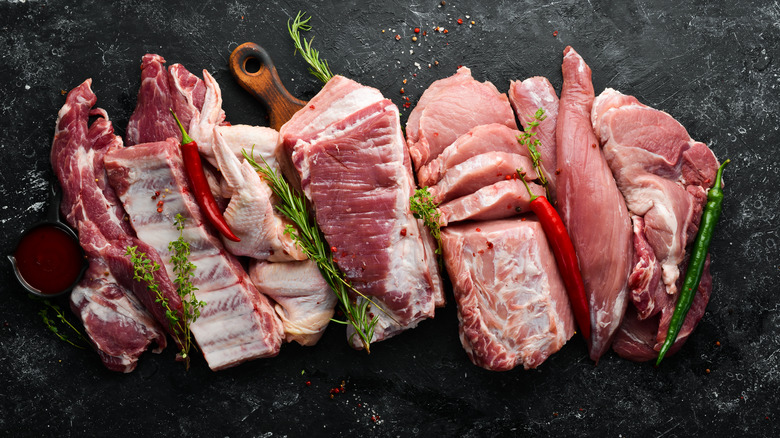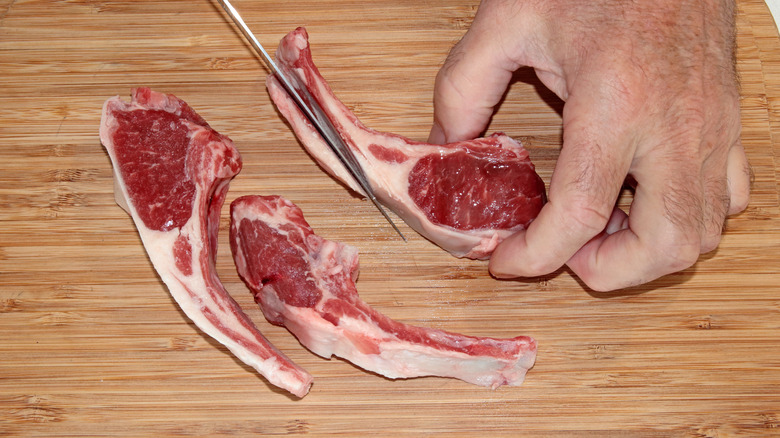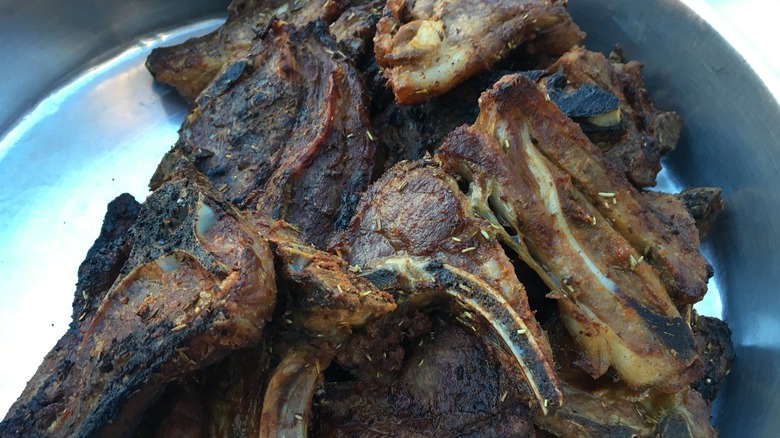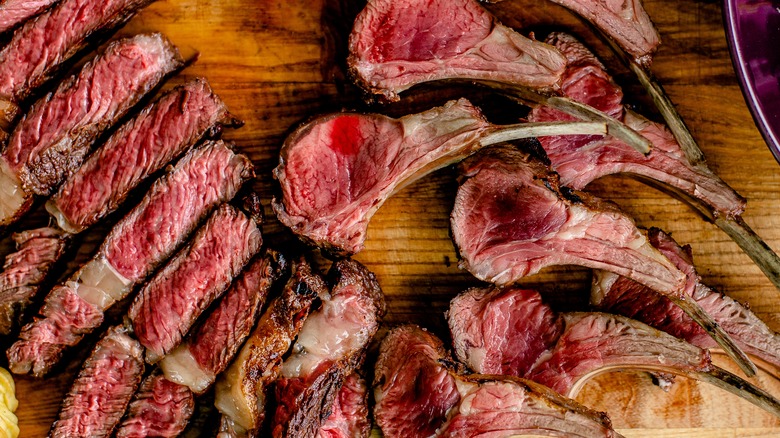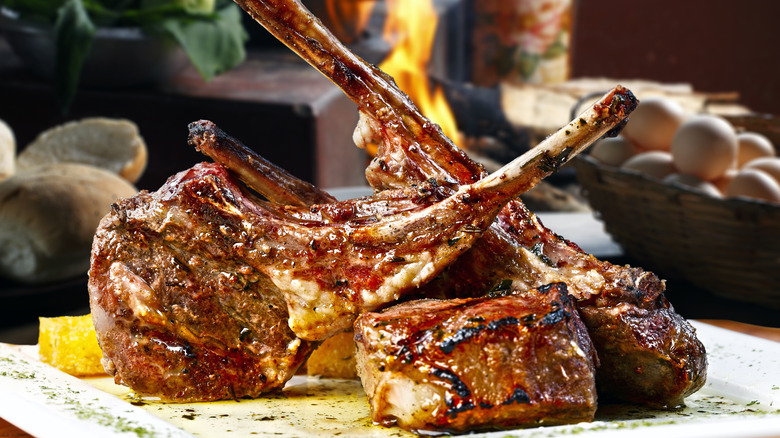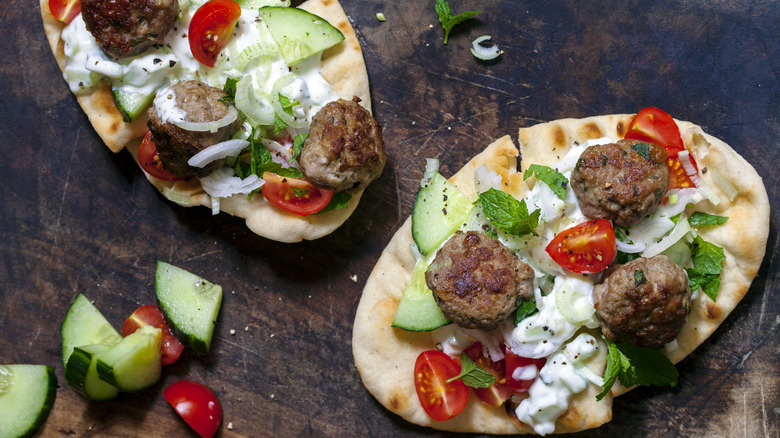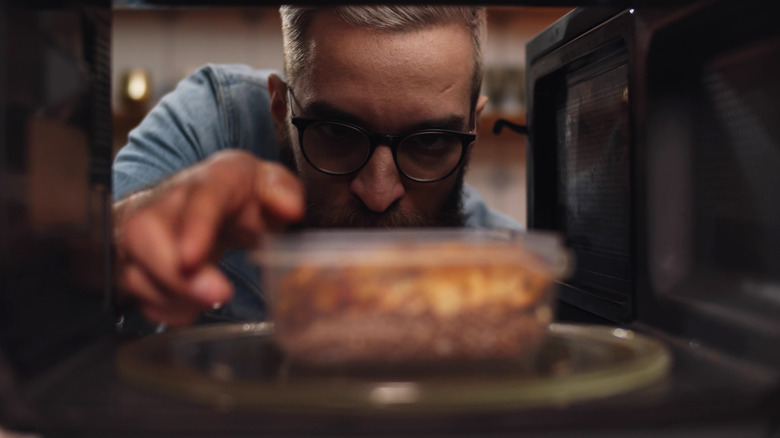The Biggest Mistakes You Need To Avoid With Lamb
Cooking lamb might seem like an exercise in futility to certain people, with the luxurious (and expensive!) meat often emerging from the oven or grill fatty, gamey, or tough. But put your memories of greasy, overcooked lamb chops with cloying mint sauce behind you. The truth is that there are a few ways you can ensure that you will fall head over heels with this complex and delicious meat.
We've assembled some of the most common mistakes people make with lamb, from choosing the wrong cut to over or under-cooking it. And we're providing tips to troubleshoot the gravest of errors, from what to do with the tough cuts to how to reheat lamb so that it stays tender and juicy. No matter your beef with lamb, this guide will help you on your journey from start to finish. Here are the biggest mistakes you need to stop making for lamb.
Forgoing the variety of cuts
Nine times out of ten, when people are looking for lamb, just two cuts are on the menu: lamb chops or leg of lamb. But of course, those are far from the only cuts out there. Lucky for adventurous cooks, there are plenty of options, and each one is more delicious than the last!
Lamb's breast is synonymous with lamb belly, and according to Simply Beef & Lamb, it's an awesome, flavorful cut for beginners. It's also pretty fatty, but since much of the fat cooks off and is discarded over the course of the cooking process, it emerges tender and flavorful. It's excellent slow-cooked, a great example being this smoked lamb breast.
Another cut that doesn't get nearly enough love is lamb shoulder, which is oh-so-tasty when slow-cooked tagine-style with Moroccan spices and lemon couscous. Or you could sample lamb shank, which is delicious when slowly braised and served with a starchy side to mop up that rich, delicious sauce.
Choosing the wrong cut for a recipe
Of course, just because there's a bevy of lamb cuts out there doesn't mean you can necessarily mix and match to your heart's content. There is a proper cooking method for every cut, and using the wrong cut in a recipe means you could end up with lamb that's tough, overcooked, or undercooked.
According to myfoodbook, when it comes to slow-cooking methods like smoking or braising, the best cuts are shoulder, leg, forequarter, shank, neck, and ribs — cuts with a lot of fat and connective tissue that will break down and make the lamb tender and juicy. Interestingly, some sausages can also be slow-cooked. Other cuts, such as lamb rib or loin chops, are usually seared according to Electric City Butcher, which notes that these more delicate cuts benefit from shorter cooking times over high heat for that sought-after juicy, tender texture.
Not trimming lamb of its excess fat
One of the biggest mistakes that people make when cooking lamb is keeping all of the fat on it. Lamb contains a slightly higher content than beef, and if you don't trim it properly, you can end up with greasy and far from appetizing meat.
Australian Lamb recommends trimming the visible white fat from the outside of the cut of lamb, leaving only the intramuscular fat, which will lend flavor and juiciness to the final dish. If you want to make a rack of lamb less fatty, consider French-trimming it, which, according to Market House, calls for removing the extra layer of fat and meat from the bone of each chop. Delicious Magazine offers a step-by-step guide to make this super easy, and the result makes the chop far more elegant in appearance and keeps the cut from being too greasy.
And if trimming your lamb at home seems too overwhelming, you're in luck: A butcher will be happy to help you out! According to Market House, this slightly neater style is preferred by many butchers, who offer the service to ensure that your rack of lamb cooks up beautifully.
Overcooking lamb
When lamb is perfectly cooked, it's deliciously soft and succulent, with a pale rosy hue. But when it's overcooked, it becomes tough and chewy, an eating experience that's far from appetizing.
You're not alone if you've encountered this problem: Lamb is tough to get just right (via GrillSimply). The outlet contends that overcooking lamb is the main reason it ends up tough and dry. To solve the problem, be sure to pull it off the heat when it's a little bit underdone so that the meat can finish cooking as it rests.
Of course, if you've already overcooked your lamb, you're in a bit of a pickle. Luckily, according to MissVickie, there are a few ways to make things better. The outlet suggests adding a homemade sauce to the lamb or using the meat as a filling in pies or tacos. You could even make your own homemade rillettes or soup so that the overcooked lamb isn't wasted.
Undercooking lamb
If you're worried about overcooking lamb, it can be tempting to go too far in the other direction and undercook it. But that's not a great idea either, not just because undercooked lamb can be a bit unpleasant to chew due to its fattiness, but also because of the health risks at play.
According to the BBC, while lamb chops can be served pink, it's important to cook ground lamb thoroughly due to the possibility of Salmonella contamination, which can make your dinner guests and family gravely ill. Ground lamb recipes, such as burgers, should be browned and cooked throughout, retaining none of their original pink color. And according to Home Cook World, even lamb roasts and other cuts should be cooked to at least 145 F interior temperature to be safe. Don't worry — this temperature will still result in the ideal medium-rare lamb that's both delicious and safe to consume.
Not letting lamb rest
Perhaps the key to achieving the perfect lamb — or any meat — is resting time. Lamb, like other meats, will continue to cook when removed from the heat source, so the temperature you reach while it's on the heat isn't actually going to be the final temperature. Also, according to Australian Lamb, this technique allows the juices to redistribute in the meat after cooking, ensuring that each slice is tender and juicy.
So what does this actually mean? American Lamb recommends pulling lamb at 135 F if you hope to reach a final temperature of 145 F, aka medium-rare. For medium, remove the lamb at 150 F; for well-done, pull it at 160 F, so it has time to reach 170 F.
As for how long to rest the meat, Australian Lamb recommends about a minute per 100 grams — aka 3 ½ ounces — for the perfect final bite.
Not thinking outside of the box
Perhaps the most common way of enjoying lamb is roasted with rosemary, garlic, or a mint sauce, but there are countless other ways you can spice up this delicious meat. If you're looking for something beyond the standard hamburger, ground lamb is super tasty in a burger, especially when paired with cumin, coriander, or cinnamon. Topped with an herbaceous yogurt sauce and quick-pickled red onions, it's a fun play on a classic that's also perfect for grilling season. Ground lamb is also awesome in kofta form, a Middle Eastern-style meatball that's delicious when cooked over a grill.
In winter, meanwhile, take a cue from Morocco and slow-cook lamb shank with warm spices, harissa, and a touch of honey for a sweet-and-savory dish the whole family is sure to love. Pair the dish with rice or couscous to soak up all of that heavenly, heady gravy, and you'll be in culinary heaven!
Reheating leftover lamb improperly
If your lamb was cooked perfectly, chances are, reheating it will pose a bit of a problem. After all, how can you ensure you enjoy the leftovers hot without accidentally overcooking them and pushing the meat into the dry, tough territory?
GrillSimply has a few recommendations, including the trick of adding a bit of stock to the meat when reheating in the oven or microwave to ensure the lamb doesn't dry out. You could also toss it into a braise with tomato paste or stout, according to Martha Stewart, which are also suitable methods for rescuing lamb that's already overcooked.
Yet another option? Forego reheating it at all! Cold lamb sandwiches with tapenade, watercress, and, appropriately, caciocavallo (aka sheep's cheese) are a delightful treat (via Serious Eats). This method will ensure that your perfectly trimmed, seasoned, cooked piece of lamb is just as delicious, even the next day.
